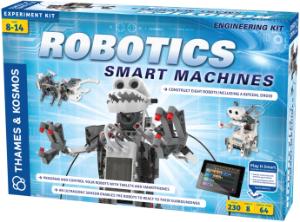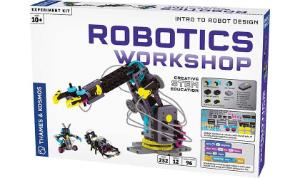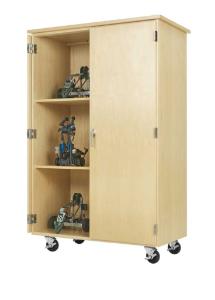Robotics Design & Applications; Plus handout from AccessScience
Access to this content is available to Ward’s World readers for free from McGraw Hill’s AccessScience, an award-winning, digital STEM resource that provides immediate, authoritative answers to students’ thirst for scientific knowledge on topics such as climate change, virology, pollution, and more. Ward’s World and McGraw Hill have partnered to offer educators a no-obligation, free trial subscription to this product. Request your free trial today and discover how valuable AccessScience can be for you and your students.
High School
Robotics is a fascinating STEM subject that involves creating and operating mechanical or virtual devices that can perform tasks independently or with human assistance. Robotics combines computer science, electrical engineering, and mechanical engineering to design machines that can interact with the physical world, manipulate objects, and carry out specific functions or tasks. And, while we’re a long way from sentient robots like the fictional C-3PO and R2-D2, researchers and perhaps some future scientists in your class continue to be inspired to revolutionize the field and achieve the impossible.
Teaching robotics is the perfect way to use engaging and interactive activities that foster collaboration and have real-world applications. Your lessons can expose students to cutting-edge technology and practical applications in manufacturing, healthcare, agriculture, space exploration, and more. Connecting to the real world helps students see the direct impact of science on their lives and perhaps inspires them to pursue STEM careers.
Here we present some mind-blowing facts about modern robotics that highlight the incredible advancements and potential of this field that students may enjoy learning:
- Collaborative Robots (Cobots): Designed to work alongside humans in shared workspaces. These robots have sensors and safety features that allow them to collaborate with humans on tasks, enhancing efficiency, productivity, and safety in various industries. The Universal Robots UR10 is a popular cobot used in manufacturing automation.
- Exoskeleton Technology: Wearable robotic devices that can augment human capabilities. They assist people with mobility impairments, enabling them to walk, lift heavy objects, or regain control over their limbs. Exoskeleton technology has immense potential in medical rehabilitation and industrial applications. The EksoGT exoskeleton, for example, assists people with lower limb disabilities or impairments in regaining mobility and walking ability. It comprises motorized hip and knee joints, sensors, and a control system.
- Swarm Robotics: Inspired by the behavior of social insects like ants and bees, swarm robotics involves a collective system of small robots that work together to accomplish tasks. These robots communicate and coordinate their actions, leading to efficient problem-solving and flexibility in complex environments. For example, Kilobots are small, low-cost robots that operate as a collective system to accomplish tasks. Developed by researchers at Harvard University, Kilobots help demonstrate the principles of swarm intelligence and collective behavior.1 NASA is exploring the concept of robot swarms for space exploration.2 These swarms of small robots could work together to gather data, repair equipment, and explore celestial bodies. By leveraging collective intelligence, these robot swarms could revolutionize space missions and help us understand the universe better.
- Soft Robotics: Traditional robots are often rigid and inflexible, but the emerging field of soft robotics focuses on creating robots with flexible, elastic materials. Soft robots mimic natural movements and interactions, enabling them to navigate irregular terrains, handle delicate objects, and adapt to dynamic environments. Soft robots can be used in surgical procedures as they can navigate through delicate tissues without causing damage. These robots can access tight spaces and navigate uneven terrains, perfect for search and rescue operations in disaster-stricken areas or confined environments like collapsed buildings. Their soft exoskeletons and wearable format can also help people with mobility impairments, aid in rehabilitation, or enhance workers’ strength and endurance in physically demanding jobs.
- Humanoid Robots: Humanoid robots aim to replicate human form and behavior. They possess features like a head, arms, legs, and facial expressions. These robots are being developed for various applications, such as companionship, caregiving, and even performing complex tasks in hazardous environments. A well-known example is Pepper, developed by SoftBank Robotics. Pepper can interact with humans in various settings. It has a humanoid appearance, with a head, arms, and a body, and stands about 4’ tall.
- Autonomous Vehicles: Autonomous vehicles, including self-driving cars, are a remarkable achievement in robotics and artificial intelligence. These vehicles use advanced sensors, cameras, and machine learning algorithms to navigate roads, detect obstacles, and make informed decisions, potentially revolutionizing the transportation industry. Now that takes some serious drive!
- Surgical Robotics: Robotics has revolutionized the field of surgery. Surgeons can now perform minimally invasive procedures with the help of robotic systems, allowing for enhanced precision, reduced invasiveness, and faster patient recovery times. Robotic surgical systems enable surgeons to perform complex procedures with greater dexterity and control.
- Artificial Intelligence Integration: Modern robotics extensively incorporates artificial intelligence (AI) to enhance robot capabilities. AI algorithms enable robots to learn from data, make decisions, and adapt to changing circumstances. This integration empowers robots to perform complex tasks, recognize objects, understand speech, and interact with humans more naturally. Amazon's Alexa, Apple's Siri, and Google Assistant are familiar examples.
- Drones and Unmanned Aerial Vehicles (UAVs): Drones and UAVs are versatile robotic devices that have gained widespread popularity. They are used for aerial photography, surveillance, package delivery, agricultural monitoring, and disaster response. These agile flying machines have opened new possibilities in various industries, but we won’t drone on about it here.
- Robot Swarms in Space: NASA has been exploring the concept of robot swarms for space exploration.2 These swarms of small robots could work together to gather data, repair equipment, and explore celestial bodies. By leveraging collective intelligence, these robot swarms could revolutionize space missions and help us understand the universe better.
Students will be thrilled to know that these facts only scratch the surface of the incredible advancements in modern robotics.
Download McGraw Hill’s AccessScience article, Robotics, covering concepts in robotics design, development, and applications. The free download also includes assessment questions and answers you can use to test student understanding.
1. Harvard School of Engineering and Applied Sciences: Self-organizing Systems Research Group. 2. NASA Jet Propulsion Laboratory: Swarm of Tiny Swimming Robots Could Look for Life on Distant Worlds
Recommended Products
[StartProductBlock]

Robotics: Smart Machines
A simple, fun, and customizable introduction to robotics. Students build eight motorized machines controlled by programs and an ultrasound sensor.
[EndProductBlock]
[StartProductBlock]

Robotics Workshop
A complete robotics engineering system to build and program your own robots. Includes Step-by-step illustrated building, programming, and operating instructions.
[EndProductBlock]
[StartProductBlock]

Mobile Robotics Cabinet
Mobile robotics storage with room for six competition-size robots. The durable cabinet moves easily on 4" heavy-duty locking casters.
[EndProductBlock]
